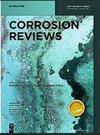通过微观结构建模模拟沉淀硬化镍基合金 718 中的氢扩散
IF 2.7
4区 材料科学
Q3 ELECTROCHEMISTRY
引用次数: 0
摘要
环境辅助开裂会严重影响高强度合金的性能,并限制材料的选择,以最大限度地降低使用过程中出现亚临界裂纹的风险。UNS N07718 因其在这些环境中的耐腐蚀性和抗断裂性,被广泛应用于海洋服务应用和各种条件下,例如:交替浸泡、不同程度的阴极保护和自由腐蚀电偶。在这项工作中,我们建立了一个具有代表性的材料微观结构模型,其中包括金属晶粒、材料纹理以及沿晶界和晶粒内部的沉淀物。该微观结构模型适用于断裂力学样品缺口根部确定的边界条件,其结果被用作缺口表面氢扩散模拟的输入,假设材料已进入产氢环境。氢的扩散以菲克定律为模型,并将静水压力和移动位错速度作为驱动力。还模拟了不动位错的影响,以解释不可逆捕集。结果表明,静水压力和不可逆位错捕集可显著改变微结构中氢的最高浓度及其在断裂过程区的位置。移动位错速度对决定断裂加工区附近的氢分布影响较小。本文章由计算机程序翻译,如有差异,请以英文原文为准。
Modeling hydrogen diffusion in precipitation hardened nickel-based alloy 718 by microstructural modeling
Environmentally assisted cracking can significantly affect the performance of high strength alloys and limit material selection to minimize the risk of subcritical crack growth in service. UNS N07718 is widely used in marine service applications and under a variety of conditions, such as: alternate immersion, different levels of cathodic protection, and freely corroding galvanic couples, because of its demonstrated corrosion and fracture resistance in these environments. In this work we developed a representative model of the material microstructure including the metal grains, the material texture, and the precipitates along the grain boundaries and within the grains. The microstructural model was subjected to the boundary conditions identified at the notch root of a fracture mechanics sample and the results are used as input for a simulation of hydrogen diffusion from the surface of the notch, assuming the material has been introduced to a hydrogen producing environment. The diffusion of hydrogen was modeled by Fick’s law and included both hydrostatic stress and mobile dislocation velocity as driving forces. The influence of immobile dislocations was also modeled to account for the irreversible trapping. The results show that hydrostatic stress and immobile dislocation trapping can significantly alter the highest concentration of hydrogen and its location within the microstructure towards the fracture process zone. Mobile dislocation velocity has a small influence in determining the hydrogen distribution near the fracture process zone.
求助全文
通过发布文献求助,成功后即可免费获取论文全文。
去求助
来源期刊

Corrosion Reviews
工程技术-材料科学:膜
CiteScore
5.20
自引率
3.10%
发文量
44
审稿时长
4.5 months
期刊介绍:
Corrosion Reviews is an international bimonthly journal devoted to critical reviews and, to a lesser extent, outstanding original articles that are key to advancing the understanding and application of corrosion science and engineering in the service of society. Papers may be of a theoretical, experimental or practical nature, provided that they make a significant contribution to knowledge in the field.
 求助内容:
求助内容: 应助结果提醒方式:
应助结果提醒方式:


